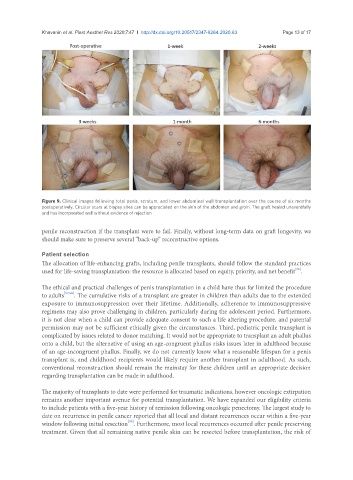Page 542 - Read Online
P. 542
Khavanin et al. Plast Aesthet Res 2020;7:47 I http://dx.doi.org/10.20517/2347-9264.2020.63 Page 13 of 17
Figure 9. Clinical images following total penis, scrotum, and lower abdominal wall transplantation over the course of six months
postoperatively. Circular scars at biopsy sites can be appreciated on the skin of the abdomen and groin. The graft healed uneventfully
and has incorporated well without evidence of rejection
penile reconstruction if the transplant were to fail. Finally, without long-term data on graft longevity, we
should make sure to preserve several “back-up” reconstructive options.
Patient selection
The allocation of life-enhancing grafts, including penile transplants, should follow the standard practices
[56]
used for life-saving transplantation: the resource is allocated based on equity, priority, and net benefit .
The ethical and practical challenges of penis transplantation in a child have thus far limited the procedure
to adults [57,58] . The cumulative risks of a transplant are greater in children than adults due to the extended
exposure to immunosuppression over their lifetime. Additionally, adherence to immunosuppressive
regimens may also prove challenging in children, particularly during the adolescent period. Furthermore,
it is not clear when a child can provide adequate consent to such a life altering procedure, and parental
permission may not be sufficient ethically given the circumstances. Third, pediatric penile transplant is
complicated by issues related to donor matching. It would not be appropriate to transplant an adult phallus
onto a child, but the alternative of using an age-congruent phallus risks issues later in adulthood because
of an age-incongruent phallus. Finally, we do not currently know what a reasonable lifespan for a penis
transplant is, and childhood recipients would likely require another transplant in adulthood. As such,
conventional reconstruction should remain the mainstay for these children until an appropriate decision
regarding transplantation can be made in adulthood.
The majority of transplants to date were performed for traumatic indications, however oncologic extirpation
remains another important avenue for potential transplantation. We have expanded our eligibility criteria
to include patients with a five-year history of remission following oncologic penectomy. The largest study to
date on recurrence in penile cancer reported that all local and distant recurrences occur within a five-year
[59]
window following initial resection . Furthermore, most local recurrences occurred after penile preserving
treatment. Given that all remaining native penile skin can be resected before transplantation, the risk of

